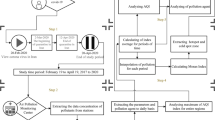Abstract
The pathogen of the disease COVID-19 is the extreme acute respiratory syndrome COVID-19 especially in the elderly and asthmatics. In our study, we examine if long-term exposure to air pollution raises the infection situations of COVID-19 in kingdom of Saudi Arabia (KSA). Through our studies, we proved that there is an associative relationship among the air pollution factor besides, the spread of COVID-19. As the results showed that compounds of air pollution such as Carbon monoxide (CO), Ozone (O3), Sulphur dioxide (SO2), Nitrogen dioxide (NO2), and PARTICLES (PM10), are severely related to the occurrence of COVID-19 due to the rate of the ratio of these areas more in the areas with the most prevalence of cases of COVID-19, so we used in our study the SIR model. It is considered one of the easiest, most reliable tools, consisting of three compartments; prone, contaminated, and removed. Besides, we utilized the Runge-Kutta method.
Access this chapter
Tax calculation will be finalised at checkout
Purchases are for personal use only
Similar content being viewed by others
References
ElSharkawy, M.F., Ibrahim, O.A.: Sources and concentrations of acidic constituents in the ambient air of Saudi Arabia. Air Qual. Atmos. Health 12(10), 1207–1214 (2019). https://doi.org/10.1007/s11869-019-00737-1
Mollalo, A., Vahedi, B., Rivera, K.M.: GIS-based spatial modeling of COVID-19 incidence rate in the continental United States. Sci. Total Environ. 728, 138884 (2020). https://doi.org/10.1016/j.scitotenv.2020.138884
Contini, D., Costabile, F.: Does air pollution influence COVID-19 outbreaks? Atmosphere (Basel) 11(4), 377 (2020). https://doi.org/10.3390/ATMOS11040377
Cui, Y., et al.: Air pollution and case fatality of SARS in the People’s Republic of China: an ecologic study. Environ. Heal. Glob. Access Sci. Source 2, 1–5 (2003). https://doi.org/10.1186/1476-069X-2-1
Habeebullah, T.M.: An analysis of air pollution in Makkah - a view point of source identification. EnvironmentAsia 6(2), 11–17 (2013). https://doi.org/10.14456/ea.2013.12
Kamerlin, S.C.L., Kasson, P.M.: Managing coronavirus disease 2019 spread with voluntary public health measures: Sweden as a case study for pandemic control. Clin. Infect. Dis. 71(12), 3174–3181 (2020). https://doi.org/10.1093/cid/ciaa864
Kang, D., Choi, H., Kim, J.H., Choi, J.: Spatial epidemic dynamics of the COVID-19 outbreak in China. Int. J. Infect. Dis. 94(January), 96–102 (2020). https://doi.org/10.1016/j.ijid.2020.03.076
Alzahrani, S.I., Aljamaan, I.A., Al-Fakih, E.A.: Forecasting the spread of the COVID-19 pandemic in Saudi Arabia using ARIMA prediction model under current public health interventions. J. Infect. Public Health 13(7), 914–919 (2020). https://doi.org/10.1016/j.jiph.2020.06.001
Alkhamees, A.A., Alrashed, S.A., Alzunaydi, A.A., Almohimeed, A.S., Aljohani, M.S.: The psychological impact of COVID-19 pandemic on the general population of Saudi Arabia. Compr. Psychiatry 102, 152192 (2020). https://doi.org/10.1016/j.comppsych.2020.152192
Mohammed, D.A., Tawfeeq, H.M., Ali, K.M., Rostam, H.M.: Analysis and prediction of COVID-19 outbreak by a numerical modelling. Iraqi J. Sci. 62(5), 1452–1459 (2021). https://doi.org/10.24996/ijs.2021.62.5.8
Konstantinoudis, G., Padellini, T., Bennett, J., Davies, B., Ezzati, M., Blangiardo, M.: Long-term exposure to air-pollution and COVID-19 mortality in England: a hierarchical spatial analysis. Environ. Int. 146(September 2020), 106316 (2021). https://doi.org/10.1016/j.envint.2020.106316
Franch-Pardo, I., Napoletano, B.M., Rosete-Verges, F., Billa, L.: Spatial analysis and GIS in the study of COVID-19. A review. Sci. Total Environ. 739, 140033 (2020). https://doi.org/10.1016/j.scitotenv.2020.140033
Díaz-Avalos, C., Juan, P., Chaudhuri, S., Sáez, M., Serra, L.: Association between the new COVID-19 cases and air pollution with meteorological elements in nine counties of New York state. Int. J. Environ. Res. Public Health 17(23), 1–18 (2020). https://doi.org/10.3390/ijerph17239055
Pascawati, N.A., Satoto, T.B.T.: Public knowledge, attitudes and practices towards COVID-19. Int. J. Public Heal. Sci. 9(4), 292–302 (2020). https://doi.org/10.11591/ijphs.v9i4.20539
Huang, F., Liu, D., Tan, X., Wang, J., Chen, Y., He, B.: Explorations of the implementation of a parallel IDW interpolation algorithm in a Linux cluster-based parallel GIS. Comput. Geosci. 37(4), 426–434 (2011). https://doi.org/10.1016/j.cageo.2010.05.024
Ben Maatoug, A., Triki, M.B., Fazel, H.: How do air pollution and meteorological parameters contribute to the spread of COVID-19 in Saudi Arabia? Environ. Sci. Pollut. Res. 28(32), 44132–44139 (2021). https://doi.org/10.1007/s11356-021-13582-6
Salman, A., Al-Tayib, M., Hag-Elsafi, S., Zaidi, F.K., Al-Duwarij, N.: Spatiotemporal assessment of air quality and heat island effect due to industrial activities and urbanization in Southern Riyadh, Saudi Arabia. Appl. Sci. 11(5), 1–16 (2021). https://doi.org/10.3390/app11052107
Morsy, E., Habeebullah, T.M., Othman, A.: Assessing the air quality of megacities during the COVID-19 pandemic lockdown: a case study from Makkah City, Saudi Arabia. Arab. J. Geosci. 14(7), 1–12 (2021). https://doi.org/10.1007/s12517-021-06898-7
Author information
Authors and Affiliations
Corresponding author
Editor information
Editors and Affiliations
Rights and permissions
Copyright information
© 2022 ICST Institute for Computer Sciences, Social Informatics and Telecommunications Engineering
About this paper
Cite this paper
Alharbi, N.H., Alharthi, Z.S., Alanezi, N.A., Syed, L. (2022). Spatial Analysis of COVID 19 in KSA Related to Air Pollution Factor. In: Sheikh, Y.H., Rai, I.A., Bakar, A.D. (eds) e-Infrastructure and e-Services for Developing Countries. AFRICOMM 2021. Lecture Notes of the Institute for Computer Sciences, Social Informatics and Telecommunications Engineering, vol 443. Springer, Cham. https://doi.org/10.1007/978-3-031-06374-9_29
Download citation
DOI: https://doi.org/10.1007/978-3-031-06374-9_29
Published:
Publisher Name: Springer, Cham
Print ISBN: 978-3-031-06373-2
Online ISBN: 978-3-031-06374-9
eBook Packages: Computer ScienceComputer Science (R0)




